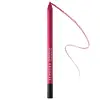What's inside
What's inside
 Key Ingredients
Key Ingredients

 Benefits
Benefits

 Concerns
Concerns

 Ingredients Side-by-side
Ingredients Side-by-side

Simmondsia Chinensis Seed Oil
EmollientCopernicia Cerifera Cera
EmollientDextrin Isostearate
Skin ConditioningSqualane
EmollientCaprylic/Capric Triglyceride
MaskingDicalcium Phosphate
AbrasiveCandelilla Cera
EmollientCastor Isostearate Succinate
Skin ConditioningMica
Cosmetic ColorantHydrogenated Castor Oil
EmollientCalcium Silicate
AbsorbentTocopherol
AntioxidantCI 77891
Cosmetic ColorantCI 77491
Cosmetic ColorantCI 77492
Cosmetic ColorantCI 77499
Cosmetic ColorantCI 15850
Cosmetic ColorantPolyglyceryl-2 Triisostearate
EmulsifyingParaffin
PerfumingPolybutene
Phytosteryl/Isostearyl/Cetyl/Stearyl/Behenyl Dimer Dilinoleate
Skin ConditioningOzokerite
Emulsion StabilisingCeresin
Emulsion StabilisingMicrocrystalline Wax
Emulsion StabilisingHydrogenated Vegetable Oil
EmollientBeeswax
Emulsion StabilisingHydrogenated Palm Acid
Stearyl Stearate
EmollientBHT
AntioxidantCI 77891
Cosmetic ColorantCI 77491
Cosmetic ColorantCI 15850
Cosmetic ColorantCI 42090
Cosmetic ColorantCI 19140
Cosmetic ColorantCI 45410
Cosmetic ColorantCI 15985
Cosmetic ColorantCI 17200
Cosmetic ColorantPolyglyceryl-2 Triisostearate, Paraffin, Polybutene, Phytosteryl/Isostearyl/Cetyl/Stearyl/Behenyl Dimer Dilinoleate, Ozokerite, Ceresin, Microcrystalline Wax, Hydrogenated Vegetable Oil, Beeswax, Hydrogenated Palm Acid, Stearyl Stearate, BHT, CI 77891, CI 77491, CI 15850, CI 42090, CI 19140, CI 45410, CI 15985, CI 17200
Ingredients Explained
These ingredients are found in both products.
Ingredients higher up in an ingredient list are typically present in a larger amount.
Ci 15850 is the pigment color red. It is an azo dye and created synthetically.
Azo dyes need to be thoroughly purified before use. This allows them to be more stable and longer-lasting.
This ingredient is common in foundations, lipsticks, and blushes. This color is described as brown/orangey red.
It has many secondary names such as Red 6 and Red 7. According to a manufacturer, Red 6 usually contains aluminum.
Learn more about CI 15850Ci 77491 is also hydrated iron III oxide. It's sole purpose is to give a red/pink hue to products.
Iron III oxides are classified as inorganic chemicals for coloring.
Synthetically created Ci 77491 is considered safer than those naturally found. This is because the synthetically created version may contain less impurities. Iron oxides are generally non-toxic and non-allergenic.
Learn more about CI 77491Ci 77891 is a white pigment from Titanium dioxide. It is naturally found in minerals such as rutile and ilmenite.
It's main function is to add a white color to cosmetics. It can also be mixed with other colors to create different shades.
Ci 77891 is commonly found in sunscreens due to its ability to block UV rays.
Learn more about CI 77891